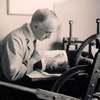Your shopping cart is empty!
Select currency
MENU

Leonard Beaumont was a Sheffield born printmaker, graphic designer, illustrator and publisher. Leaving school at sixteen, Beaumont worked for The Sheffield Daily Telegraph producing black and white advertisements, but in the evening he attended Sheffield Technical School of Art where he excelled at drawing and elementary printmaking, so much so that he was awarded a West Riding of Yorkshire Scholarship, which allowed him to enroll full time, and extend his studies for a further three years.
Leonard Beaumont’s schooling was interrupted by the First World War in which he served with the Royal Naval Volunteer Reserves in the East Indies and then in India and Ceylon (1915-18). Upon his return Beaumont resumed his job with The Sheffield Daily Telegraph, but also met and married Gertrude Ann Roberts, a graduate in Modern History and Education from the University of Sheffield.
Leonard Beaumont and his wife moved to London (1936) where he was offered a position as Art Director in the Publicity Department of United Artists Film Distributors. The company wanted a skilled designer who could tone down the American film posters, considered too brash and vulgar for British audiences. Such was Beaumont’s expertise - his work soon recognized amongst his peers as ranking equal to contemporary designers such as Edward McKnight Kauffer (1890-1990) and Tom Eckersley (1914-1995) - that his design skills were noticed by the British Government, and during the Second World War Beaumont was recruited to help with propaganda posters for the Ministry of Information, the Ministry of Food and the General Post Office.
After the War Leonard Beaumont was appointed the first design consultant for the burgeoning supermarket chain J. Sainsbury’s Limited (1950). The brief was to establish a uniform corporate identity, a simple design, that would reflect the company’s reputation for quality. Beaumont would overhaul Sainsbury’s approach to design. He was concerned with everything, from in-shop signage and shop fascias to product wrapping and packaging, and he retained this position until his retirement in 1964.
Leonard Beaumont is now recognized principally for his linocut prints, but his first interest was in etching. He taught himself etching after purchasing E. S. Lumsden’s ‘The Art of Etching’ (1925) and his first major works were inspired by the steel-production processes local to him in Sheffield. But Beaumont also travelled throughout mainland Europe and many of his works depict landscape views of the Alps and Swiss villages with their chalets and snow-capped peaks. And he met with critical success for his etchings, finding praise from two eminent critics of the day, Malcolm Charles Salaman and Campbell Dodgson.
It was a further book, Claude Flight’s ‘Lino-Cuts: A Handbook of Linoleum-cut Colour Printing’ (1927) which inspired Leonard Beaumont to experiment with the linocut; but even more so, it was visiting Flight’s ‘First Exhibition of British Linocuts’, held at the Redfern Gallery in 1929, which catalyzed Beaumont’s interest. He started with single-colour work, but rapidly progressed to the use of three and four-colour blocks, and by the summer of 1932 his prints were included, alongside the work of Claude Flight (see Artists) Cyril Power (see Artists) Sybil Andrews (see Artists) and other Grosvenor School artists, in the Redfern exhibition of linocuts ‘Modern Colour Prints’.
In his work, Leonard Beaumont observed Flight’s injunction to convey contemporary themes, and many depict movement and the rhythms of workaday life. Such was his fascination with the new medium that Beaumont would write an instructional book on the subject: ‘Art from Linoleum – An Introduction to Lino-Prints and How to Cut Them’ (1932) and in the following year he also brought out ‘Rhymes and Rhythms for Young People’, a children’s nursery book, which he illustrated with linocuts. These books, particularly the latter, led to commissions to illustrate further books. Beaumont produced the cover illustration, for instance, for ‘A Letter to A Young Lady On Her Marriage’, by Ambrose Hoopinton (1934) and illustrations for Leslie Allen Paul’s ‘Story Without End, The Junior Book of Co-operation’ (1935).
Leonard Beaumont’s linocuts are now enjoying a resurgence of interest and he is recognized as one of the major figures not only in British 20th century graphic design, but also as an eminent artist amongst the avant-garde linocut printmakers of the 1930’s. His prints are held in private and public collections worldwide, including The British Museum, London; Museums Sheffield; National Gallery of Canada; the National Gallery of Australia and the Victoria and Albert Museum, London.
This is a Limited Edition Giclee Print by the artist Leonard Beaumont.242mm x 205mmEdition..
£78.00 Ex Tax: £65.00
This is a Limited Edition Giclee Print by the artist Leonard Beaumont.252mm x 202mmEdition..
£78.00 Ex Tax: £65.00
This is a Limited Edition Giclee Print by the artist Leonard Beaumont.278mm x 200mmEdition..
£78.00 Ex Tax: £65.00
This is a Limited Edition Giclee Print by the artist Leonard Beaumont.200mm x 195mmEdition..
£78.00 Ex Tax: £65.00
This is a Limited Edition Giclee Print by the artist Leonard Beaumont.252mm x 202mmEdition..
£78.00 Ex Tax: £65.00
This is a Limited Edition Giclee Print by the artist Leonard Beaumont.200mm x 254mmEdition..
£78.00 Ex Tax: £65.00
This is a Limited Edition Giclee Print by the artist Leonard Beaumont.200mm x 200mmEdition..
£78.00 Ex Tax: £65.00
This is a Limited Edition Giclee Print by the artist Leonard Beaumont.247mm x 200mmEdition..
£78.00 Ex Tax: £65.00